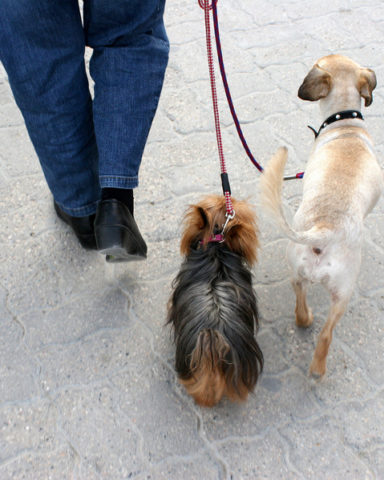When walking your dog on a leash, do you keep the leash tight? Most people do. It’s usually the style of leash walking that most dogs gravitate to — where the dog is in the lead, and you’re on the other end of the leash following (or being pulled!) along.
Have you ever tried loose leash walking?
The fact is dogs actually need to be taught how to walk on a leash the right way.
With loose leash walking, your dog trots next to you at the same exact pace that you are walking while the leash loosely dangles between the two of you. In effect, you would only need to tug on the leash if your dog got really curious or distracted and wandered off to explore something — like a tree, a person, or another dog. It’s actually more effective to just stop walking (instead of tugging on the leash) any time you need to get your dog’s attention. Loose leash walking is a great technique… and it works.
Once you’re ready to give loose leash walking a try, I’m sure that you’ll find loose leash walking is much more comfortable (and enjoyable) for both you and your dog!
The socialization period in a puppy’s life (roughly from 4-12 weeks) is the most influential time in a puppy’s life. One measure of how successful early socialization is how easily a dog walks on a leash, a significant indicator of a dog’s comfort level with humans. Well-socialized dogs feel safe around humans and like to be close to them, so they exhibit less pulling and straining. A study conducted in Maine found that puppies that spent time with humans between 5 and 9 weeks had the fewest problems on the leash, following happily, with minimal coaxing.
~Katz on Dogs
My Own Experience
I’ve definitely learned this to be true firsthand.
When walking my dogs, it is a lot easier to walk them on a loose leash. However, I will admit, it doesn’t happen all of the time.
This is something that I’m still working on.
Both of my dogs love to pull when they are being walked. My youngest Min Pin will usually stop pulling and walk beside me, so I can comfortably walk her on a loose leash now. But her sister is another story. I’m still working on loose leash walking with her!
I’ve found the following tips and video to be most helpful…
How To Teach Loose Leash Walking
For loose leash walking you want to make sure the clip to the leash stays under your dog’s chin at all times. That means there should never be any tension on the leash. When there is tension, your dog will give resistance and start to pull; it’s just a dog’s natural reaction.
This next point might seem strange, but you don’t want to start walking your dog right away as soon as you clip the leash onto your dog’s collar.
Instead, start with your feet planted firmly on the ground. Have the leash in both of your hands. Then, practice pulling back and letting the leash go slack. When the leash is slack take a step. If your dog still pulls, keep practicing with pulling back and then giving the leash some slack.
The goal is to always have some slack in the leash between you and your dog while your dog is walking next to you (rather than in front of you).
This video demonstrates how to practice loose leash walking with your dog:
Here are some tips for teaching loose leash walking, based on the age of your dog.
There is another way to keep dogs from pulling when leash walking as well…
How & Why A Gentle Leader Works
If you are still having trouble with loose leash walking, you may want to give a gentle leader head collar a try.
With a gentle leader, your dog follows (rather than leads) on walks!
I just got one, and I plan on using it on my oldest dog. I am hoping that with the help of the gentle leader head collar I will be able to walk both of my dogs on a loose leash very soon — instead of just the one.
This video shows how and why the gentle leader works:
Here are 7 ways to improve loose leash walking.





